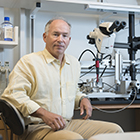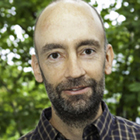
Reactions from SfN 2018
Spectrum heads to San Diego to cover the annual Society for Neuroscience conference.
7 November 2018: Day Five
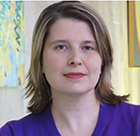
Chiara Manzini
Assistant professor, George Washington University
Cell symposium: This morning there was a truly excellent nanosymposium on how we can leverage human-induced pluripotent stem cells (iPSC) to model neurodevelopmental conditions and ask questions about neuronal differentiation and function. In particular, I was struck by a talk from Karun Singh, an associate professor at McMaster University. He discussed a new approach that investigates how one of the kinases affected by the 16p11.2 microdeletion, TAOK2, affects both protein expression and protein phosphorylation. Singh’s team identified isoform-specific deficits in neurons. They also defined weak and transient protein-protein interactions in order to study the protein networks and signaling altered by TAOK2beta, specifically.
In another talk, Madel Durens, a postdoctoral research fellow in Michael Nestor’s lab at the Hussman Institute for Autism, described a high-throughput method to study the proliferation, neuronal differentiation and circuit plasticity in brain organoids made from cells derived from individuals with autism. The method combined high-content screening and multi-electrode arrays in 96-well plates to analyze several features simultaneously in the cells. Such high-throughput methods will be critical in identifying the molecular and synaptic changes caused by different gene mutations in humans.

Professor, San Diego State University
Telomere twist: Blair Braden, assistant professor at Arizona State University, and colleagues reported work showing that children with autism have shorter telomeres than their typical peers. The effect is particularly strong in girls with autism. The findings add an interesting twist to the literature on sex differences in autism. More importantly, if shortened telomeres are a risk factor for early cognitive decline in aging, the findings underscore the importance of brain-behavior studies examining autism across the entire life span, including aging.
Common genes: Findings from Emanuel DiCicco-Bloom’s lab at Rutgers University add further evidence of genetic convergence in autism — the idea that different autism genes converge onto common etiological pathways. Induced pluripotent stem cells from children with idiopathic autism and from those with a 16p11.2 deletion show shared features of reduced neurite outgrowth and abnormal neuron migration. However, response to extracellular factors, such as a neural growth factor, differs between the two organoid models.
6 November 2018: Day Four
Associate professor, University of California, Davis
Touchscreen tech: It was refreshing and impressive, from a neurodevelopment and cognitive standpoint, to see that Ted Abel’s group at the University of Iowa is using touchscreen testing in multiple mouse models of autism — namely 16p11.2, CNTNAP2 and SHANK3b. We’ve been using this methodology for a long time and are happy with its outputs, so I’m delighted to see others in the field start to rigorously pursue this strategy, too.
Motor phenotype: There were several posters today highlighting fine motor skills in autism. Increasingly, there is recognition that motor skills are a key phenotype in many autism mouse models, so it was amazing to see the phenotype well represented in the posters at SfN.
One of my favorite posters was on learning and memory in rodents. The researchers did a placebo surgery on 25 rats and introduced a hippocampal lesion in 27 others — an impressive sample size. They were testing the hypothesis that hippocampal participation is essential during learning. Both groups showed intact context discrimination and memory retention — a novel finding. Overall, this doesn’t corroborate traditional memory consolidation predictions. It also highlighted how non-hippocampal networks actively engage and support context discrimination — a surprise to our group.
Professor, San Diego State University
Development data: University College London professor emeritus Janette Atkinson and University of Oxford professor emeritus Oliver Braddick presented neuroimaging and behavioral findings from studies in typically developing infants and children with prenatal brain lesions. Among the paradigms they are using is a visual motion detection (‘ball in grass’) task that specifically taps into functions of the visual dorsal stream. Interestingly, in typically developing children, they find that the early development of the brain’s parietal regions is associated with improvements in global motion sensitivity.
More importantly, findings from many types of neurodevelopmental conditions, including autism, suggest a selective vulnerability of the dorsal stream, with relative impairment of motion processing and relative sparing of object perception. Atkinson and Braddick argue that this is of particular importance, particularly given the tight links between dorsal stream and attention networks.
Functional findings: There has been a lot of debate recently about the reliability of findings from resting-state functional magnetic resonance imaging (fMRI) data in autism. There is increasing awareness of the many factors that can affect findings, including motion in the scanner, respiration, caffeine intake, time of day, open versus closed eyes and more.
Lisa Byrge, a postdoctoral scholar in Dan Kennedy’s lab at Indiana University, presented findings from large samples of participants in the Human Connectome Project who were scanned multiple times on different days. Using ‘connectional fingerprints,’ the group was able to identify individuals across sessions with almost perfect reliability. This was possible using only a small subset of the very large number of total connections in the whole brain connectome.
These findings support the reliability of resting-state fMRI data. If connectivity patterns are distinctive — independent of imaging session — across typically developing individuals, the ability of resting state fMRI to identify distinctive differences between participants with autism and typically developing participants can be expected to be equally reliable. This does not imply, of course, that functional connectivity researchers in autism should in any way cut down on crucial efforts to improve noise in the data.

Research associate, Mouse Imaging Centre, Hospital for Sick Children, Toronto
A new lens: Jonathan Sebat, professor at the University of California, San Diego, gave a thought-provoking talk today on a CACNG2 mouse model of autism. He posited that the genes that aren’t generally considered the ‘top-tier genes’ — in this case, CACNG2 — can be just as interesting targets for investigation, and ultimately lead to viable treatments for these ‘ultra-rare’ cases. It is an interesting proposition: Knowing the specific effect of the CACNG2 gene and having a known treatment for its mutation is a powerful finding for individuals who carry the mutation. His talk led me to wonder: If a treatment can work in these lower-tier genes, then can it be applied to develop treatments for the top-tier genes as well?
Professor, Rutgers University
Critical chromatin: CHD8 is a chromatin-modifying gene that can activate or repress gene expression. In humans, mutations in the gene can lead to autism, macrocephaly and intellectual disability. In past modeling of this gene in mice, heterozygous deletion led to variable developmental effects on neuron proliferation, neurogenesis and distinct behavioral features.
To further define the effects of the deletion, Albert Basson, a professor at King’s College London, has created mice with only partial reductions in CHD8. which have only 25 percent and 15 percent residual expression levels of the gene. These ‘hypomorphs’ have specific increases in their subventricular zone (SVZ-Tbr2) neuronal precursor proliferation and increased brain size. Interestingly, the lab found that when CHD8 levels are further reduced, the exaggerated proliferation is reversed and, instead, cell-death pathways emerge, producing brain microcephaly.
These studies highlight the critical importance for understanding autism of investigating the genes that regulate very early developmental processes in the embryonic brain. They demonstrate how complex interactions between the levels of gene expression differentially control downstream regulators of neurogenesis and lead to diverse brain features on a spectrum of severity. This could mirror the clinical variability within and between individuals who have apparently similar genetic risk alleles.
Postdoctoral fellow, California Institute of Technology
Connectivity clues: Functional brain organization is a highly relevant topic in autism research. Today I saw two excellent posters by Dan Kennedy’s lab from Indiana University related to connectivity. Using multi-scale community detection, postdoctoral research associate Ye He presented results showing that autism brains have more heterogeneous functional network organization at the system level. This work emphasizes the need to take individual differences into account, as opposed to studying only group-level results in autism.
In another poster, Lisa Byrge investigated the limits of identifying individuals based on their functional connectomes. Surprisingly, only a tiny subset of connections in the connectome was sufficient to predict individual identity. I’m looking forward to the application of these findings to our understanding of heterogeneity in autism.
Assistant professor, Institute of Science and Technology Austria
Genes to molecules: In an afternoon session chaired by Albert Basson, speakers covered the study of some autism-associated genes in mouse and cell models. Wendy Wenderski, a graduate student in the Crabtree Lab at Stanford University, spoke about autosomal recessive mutations in the gene BAF53b identified in individuals with a severe form of autism. The results were supported by an analysis of mutant BAF53b mice, which have behavioral issues and molecular differences. Interestingly, when BAF53b is missing, the gene BAF53a takes over, resulting in viable yet impaired animals. In vitro, neuronal cell culture indicates that BAF53b regulates activity-dependent gene transcription.
Subtype strategy: To demonstrate the feasibility of personalized medicine, Jonathan Sebat is using a mouse carrying an individual-specific mutation in the gene CACNG2 to identify potential therapeutic strategies. Sebat hinted at the possibility that among ultra-rare mutations, there may be several that could be easily treatable.
5 November 2018: Day Three

Assistant professor, University of Michigan
Neuron nuances: To subtype neurons, we must take various descriptive factors into account, including molecular identity, morphology, physiology and connectivity. Today, in a minisymposium on multidimensional neuron cell-type classification in the cerebral cortex, a series of talks highlighted recent efforts to use multimodal approaches to systematically describe human and rodent neocortex neuronal types. They illuminated important new neurobiology, including the remarkable diversity of VIP neurons and a detailed characterization of layer 1 of the neocortex.
One presentation that really stood out was from a team at Janelia Research Campus, who have identified two subtypes of pyramidal tract layer 5 neurons with distinct sublaminar locations, corticofugal connectivity and gene expression patterns. Remarkably, these neuronal subtypes contribute to distinct aspects of motor behaviors, highlighting a key functional difference.
In addition, a team from the Center of Advanced European Studies and Research in Germany identified a novel layer 5 neuron type that showed distinct and, in some ways, unexpected connectivity patterns. Together, these discoveries highlight how technological advances have enabled increasingly detailed investigations of cell types. They show how such integrative analyses can illuminate novel aspects of circuit biology.
Postdoctoral fellow, California Institute of Technology
Biomarker quest: The size of SFN might be overwhelming at times, but what an opportunity to reconnect and build new connections with so many scientists working on different aspects of autism research! I spent most of my morning listening to exciting work presented at the nanosymposium on structural and functional brain changes and how these may relate to autism traits in children. The breadth of methods and metrics used to detect potential biomarkers was inspiring, especially those that can be used in infants so early in development.
Laurel Gabard-Durnam, a postdoctoral researcher at Harvard Medical School, presented some promising work on electroencephalography (EEG) biomarkers for delayed phoneme sensitive periods in infants. Meanwhile, Bosi Chen, a doctoral student at San Diego State University, presented on atypical functional connectivity of the visual network in toddlers with autism. The quest for biomarkers is being tackled from many angles.
Data drama: Amanda Easson, a PhD student at the University of Toronto, showcased how using different methods to process brain connectivity data has a dramatic impact on what we see in terms of group effects in autism. Her research focuses on magnetic resonance imaging data, but this is important to consider for all kinds of data — really!

Research associate, Mouse Imaging Centre, Hospital for Sick Children, Toronto
Excellent EEG: A talk that piqued my interest today was presented by Abigail Dickinson, an assistant project scientist in Shafali Jeste’s lab at the University of California, Los Angeles. They were looking at alpha oscillations in high- and low-risk infants using EEG. They looked at infants aged 3 to 12 months at multiple time points to determine whether there were any early signs or biomarkers that could be indicative of an autism diagnosis later in life.
Longitudinal studies like this in infants are extremely powerful and necessary, as early diagnosis and intervention is key in autism. Hyperconnectivity seen at 3 months of age was seen in the infants that later had autism traits at 18 months old. This is interesting, as it could be related to the evidence of increased white matter at these early timepoints in infants who later show autism features. I look forward to hearing more about this study as the research progresses.
Professor, University of Missouri
Brain biomarkers: Today there was a long session on brain imaging in autism. It was filled with talks that asked important questions about autism. At the beginning of this session were several reports by the team at Washington University in St. Louis and University of North Carolina, along with other sites, reporting on using diffusion tensor imaging and functional magnetic resonance imaging (fMRI) to investigate autism features and their neural correlates.
Another talk in the session, by Charles Nelson’s team at Harvard Medical School, reported on an EEG signal at a sensitive period in neurodevelopment that may be a biomarker for autism. Identifying biomarkers in at-risk infants that predict the eventual development of autism is critical for the field. The results are promising. So far, the groups they are studying may not be large enough to say whether this is a real predictor of autism. However, the potential as a treatment biomarker already at this stage is really intriguing, as well as the promise for mechanistic understanding.
4 November 2018: Day Two
Research assistant professor, San Diego State University
Simple songs: Mala Murthy of Princeton University gave a fascinating lecture on social communication in Drosophila (fruit flies). Male Drosophila ‘sing’ in an attempt to woo females, following behind them as they walk across a surface and letting out a fluctuating sequence of sounds.
Through a series of studies conducted over several years, Murthy and her team have shown that the pattern and volume of the male’s song varies in response to the female’s distance and speed. This indicates a form of social communication in which the male sings, the female speeds ups or slows down depending on her interest level, and the male changes his tune in response.
The simplicity of the Drosophila nervous system allows Murthy and her team to record neural activity from an entire circuit of individual neurons — from sensory input to motor output — as the flies perceive, encode and respond to the activities and sounds of other flies around them, mapping social activity in one of its simplest forms.

Research associate, Mouse Imaging Centre, Hospital for Sick Children
Distinct dendrites: There were a number of excellent talks this morning in the Animal Models of Neurodevelopmental Disease session. I was particularly interested in a talk by Cyndi Schumann of the University of California, Davis MIND Institute. She looked at altered dendritic morphology in the dorsolateral prefrontal cortex of nonhuman primates that had been exposed to maternal immune activation (MIA). The effect on the brain was quite striking, causing a characteristic alteration in the shape and size of dendrites. Specifically, they became ‘skinny’ and ‘branchy’ in the MIA group, which could have profound implications throughout the prefrontal cortex. I’m interested in the large-scale implications of these changes and whether they might be detectable with magnetic resonance imaging (MRI).
Modeling sex differences: The talk on sex differences in the behaviors of 16p11.2 mice by Jacqueline Giovanniello, a graduate student in Bo Li’s lab at Cold Spring Harbor Laboratory in New York, was intriguing. I think the sex differences we’re seeing in these autism mouse models need to be investigated thoroughly across other models. We often see sex differences in the brain in our own mouse MRI studies, and because autism has sex-specific phenotypes in the human population, studies like this are imperative for understanding the condition as a whole.
Assistant professor, George Washington University
Paternal effects: I was particularly struck by a presentation by Ryuichi Kimura of Tohoku University in Miyagi, Japan, on how advancing paternal age could increase autism risk. He showed how offspring sired by older mice display multiple behavioral deficits, including decreased ultrasonic vocalizations and delayed spatial memory acquisition. DNA methylation analysis of the paternal sperm showed a widespread decrease in methylation, which appeared to preferentially activate genes involved in neural development and autism risk. Although preliminary, these findings suggest that epigenetic changes in the sperm may contribute to autism risk and increase de novo mutation rates.
Cellular correlations: Several new insights were raised in a poster by Dmitry Velmeshev, a postdoctoral researcher at the University of California, San Francisco. Velmeshev and his team completed an extensive single-cell RNA sequencing study of human prefrontal and anterior cingulate cortices taken from individuals with autism and from individuals with epilepsy but not autism. They found significant cellular differences in neurons and microglia in cortical layers 2 and 3.
They also saw a correlation between changes in genes that act in these layers and severity of autism traits. Although a lot of attention has been given to layer-5 projection neurons, this finding highlights a role for later-developing neurons and cortico-cortical connections in autism.
Professor, Rutgers University
CHD8 contributions: A poster presented by Qing Richard Lu’s lab at Cincinnati Children’s Hospital on CHD8 caught my eye. The gene CHD8 has been identified as an important chromodomain modifier that is expressed early in brain development. It also contributes to autism. This study examined the consequences of CHD8 loss for the embryonic mouse cortex. They found that it causes cell death of ventricular zone radial glia, which inhibits neuron proliferation and neurogenesis. They then use ChIP-Seq to identify many developmental regulators, including WNT pathway molecules. This study shows in which cells, and at what stages of development, this risk allele acts to alter brain development.
Professor, Harvard University
Surprising striatum: Ann Graybiel’s lecture this afternoon on the striatum captured my attention. She spoke about striosomes — which are essentially special modules in the striatum — and their role in modulating responses to aversive sensory stimuli. Her work represents a beautiful melding of circuitry and function.
Fly physiology: Mala Murthy’s talk relating sensory input to mating behavior in Drosophila was intriguing. They looked at mating ‘songs’ — essentially patterns of wing vibrations — and then related them to social behavior in the males and the females. She literally mapped brain responses to the auditory signals, which are strikingly analogous to those seen in mammals. Connecting sensory information to neural circuitry, and connecting this to emergent behavior, is the essence of why we do neuroscience.
Professor, University of Washington
Surrounded by mice: What struck me most today is that mouse models are dominating all aspects of my science — both my basic vision research and autism research. A poster session on visual circuits, which, historically, would have been dominated by monkey-related experiments, was filled with mouse-related findings. Some of these defined human-like features in mice. Others explored fundamental circuit properties on a scale that has not been previously possible.
On the autism side, I was also struck by the power of mouse models. The poster I spent the most time thinking about was related to developmental changes in a mouse model of SCN2A, a top candidate gene for autism. What starts out in development as an axon-specific change in excitability becomes a dendritic change in excitability in adults. With vision serving as an intermediary link, new opportunities to connect autism mouse models, basic research into vision in mice, and vision in people with autism seems like a viable next step.
3 November 2018: Day One
Professor, University of Missouri
Head start: Despite the fact that Saturday at SfN is only a half-day session, there was a rich variety of autism research to get the conference started.
One prominent theme was the thoughtful consideration of the multiple subtypes of autism. Valerio Zerbi of ETH Zürich in Switzerland presented results from the Autism Mouse Brain Connectome project. The team looked at brain connectivity in multiple mouse models of autism and found three distinct clusters of atypical connectivity in all of the models. This was particularly interesting in light of previous findings, which also pinpointed three clusters, based on observations of brain anatomy changes. It’s unclear how these two findings overlap, as the two groups did not use the same set of mouse models.
Untangling heterogeneity: Karla Kretschmannova, a scientist at PsychoGenics, Inc., discussed the variation in excitatory synaptic neurotransmission in the striatum and nucleus accumbens across four autism mouse models. Elsewhere, Anita Torossian, a National Institute of Mental Health fellow, discussed variability in protein synthesis across three mouse models.
This is important work; clinical trials in autism have failed thus far because of the heterogeneity of the condition. Getting a handle on these mechanisms will be critical if we want to move forward in drug development for autism.
Additionally, there’s a growing body of research looking into the different combinations of factors that can contribute to autism. Staci Bilbo‘s group at Harvard University presented several posters that detailed the effects of two factors associated with autism: prenatal stress and diesel exhaust particulate exposure. In a rodent model, they found autism-associated effects, including behavioral effects, anterior cingulate connectivity effects, microglial changes in the nucleus accumbens and sex-specific effects on the microbiome and intestinal epithelium. This kind of approach is similarly important in understanding the pathophysiology of heterogeneous conditions such as autism.
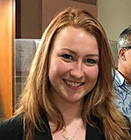
Graduate student, Rutgers University
Cerebral connectivity: Elliott Sherr of the University of California, San Francisco presented intriguing neuroimaging findings from individuals with complete agenesis of the corpus callosum (cACC). I found it interesting that cACC individuals had altered language lateralization compared with neurotypical individuals. Magnetoencephalography scans revealed dominant right-lateralized activation in cACC individuals; this is absent in neurotypical individuals, who have left-lateralized activation.
Given the association between cACC and autism, this work adds to our growing understanding of the social-communication deficits often observed in the autism population. Overall, I am excited to attend SfN during my first year of graduate school, and I look forward to hearing more stimulating presentations.
2 November 2018: Heading to San Diego
The 48th annual Society for Neuroscience (SfN) meeting kicks off Saturday morning in San Diego, California.
For five days, the city will play host to thousands of neuroscientists presenting some 14,000 abstracts. From lectures and symposia to posters and satellite socials, it may be virtually impossible to attend everything that interests you at this mammoth conference.
Spectrum is here to help. Our reporters will be on site, covering the most notable autism research findings in real time. I will also update this blog every day with attendees’ reactions from the conference floor.
Our SfN news coverage is available here. Get a roundup of the day’s news by subscribing to our newsletter, or follow Spectrum on social media to receive breaking news updates. You can find us on Facebook and Twitter.
For those attending the conference, we invite you to join us at two special events.
Help us celebrate a decade of Spectrum at our 10-year anniversary party. Learn how we choose which stories we cover and how you can write for Spectrum. Join the news team for food and drinks at the Omni Hotel San Diego in Gallery 2 at 6:30 p.m. on Sunday, 4 November. Please RSVP here.
We also invite you to participate in a live Twitter chat about the autism research presented at the conference at noon on Monday, 5 November. Meet us online or in person in the Omni Hotel San Diego lobby. We will be tweeting questions and moderating the chat using the handle @Spectrum and the hashtag #SFNChat.
We look forward to seeing you there.
Like us on Facebook » | Follow us on Twitter @Spectrum » | Subscribe to our newsletter
For more reports from the 2018 Society for Neuroscience annual meeting, please click here.
Recommended reading

Documenting decades of autism prevalence; and more

Expediting clinical trials for profound autism: Q&A with Matthew State
Explore more from The Transmitter

‘Perturb and record’ optogenetics probe aims precision spotlight at brain structures


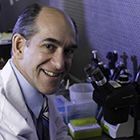

 Gaia Novarino
Gaia Novarino

